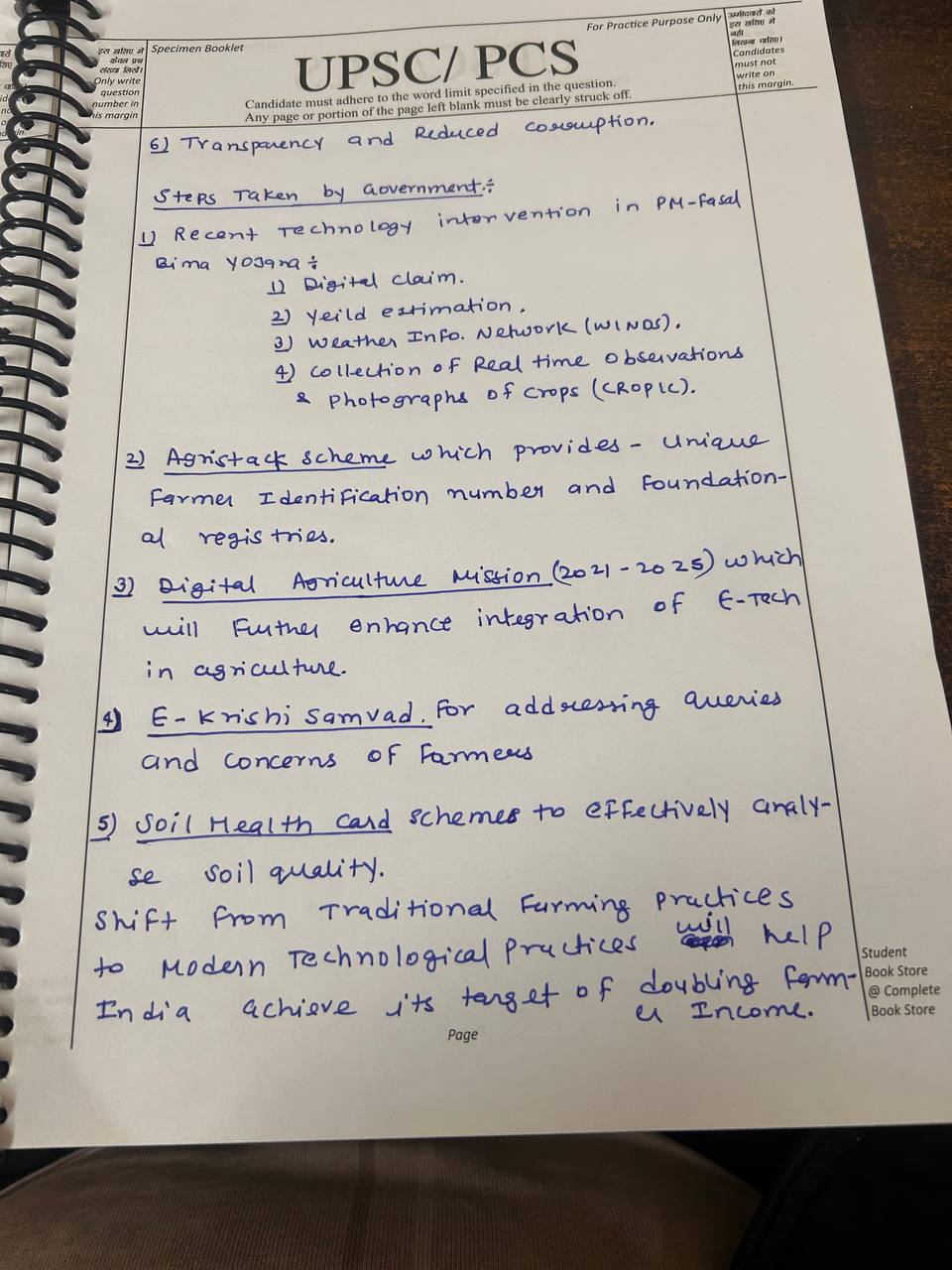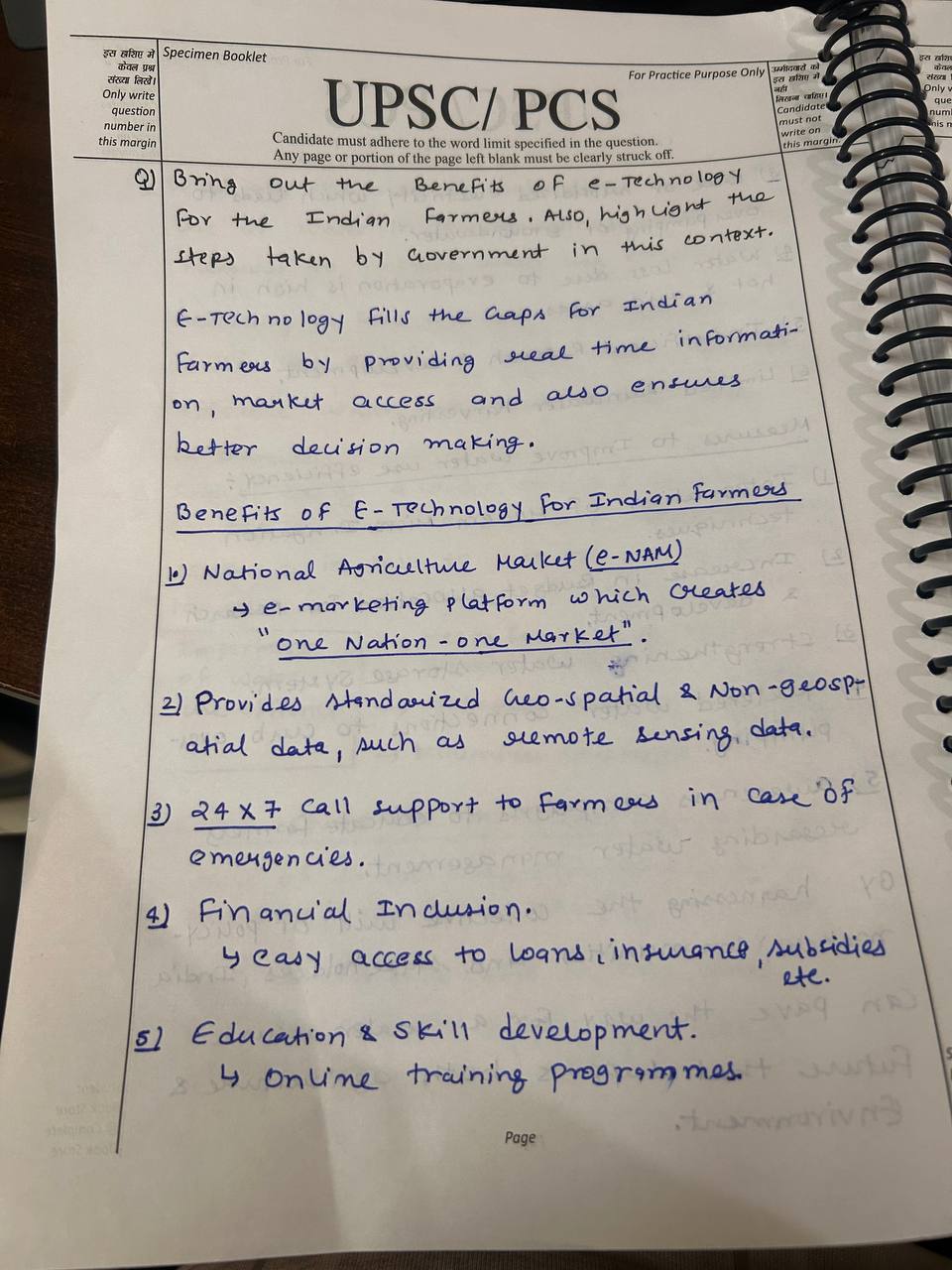Examine how blockchain technology might improve the efficiency, traceability, and transparency of agricultural supply chains. Discuss the necessary policy and legal frameworks to make this technology widely available.
Potential of IoT and Sensor-Based Technologies in Agriculture 1. Overview of IoT and Sensor-Based Technologies in Agriculture Internet of Things (IoT) and sensor-based technologies are revolutionizing agriculture by enhancing efficiency and sustainability. These technologies involve the use of interRead more
Potential of IoT and Sensor-Based Technologies in Agriculture
1. Overview of IoT and Sensor-Based Technologies in Agriculture
Internet of Things (IoT) and sensor-based technologies are revolutionizing agriculture by enhancing efficiency and sustainability. These technologies involve the use of interconnected devices and sensors that collect, transmit, and analyze data to optimize various agricultural processes. Key applications include:
- Irrigation Management
- Livestock Monitoring
- Post-Harvest Processing
2. Enhancing Efficiency and Sustainability
Irrigation Management
- Precision Irrigation: IoT sensors can monitor soil moisture levels and weather conditions to automate irrigation systems, applying water only when and where needed. This reduces water wastage and improves crop yields.
- Example: Netafim, an Israeli company, has implemented IoT-based irrigation systems in Indian states like Maharashtra and Rajasthan, significantly reducing water usage and increasing crop productivity.
Livestock Monitoring
- Health and Welfare: Sensors and wearable devices can track livestock health parameters such as body temperature, activity levels, and feeding patterns. This data helps in early detection of diseases and improves animal welfare.
- Example: ICAR-Central Institute for Research on Buffaloes has used IoT sensors to monitor buffalo health and productivity in Haryana, leading to improved herd management and disease control.
Post-Harvest Processing
- Quality Control: IoT devices can monitor storage conditions (temperature, humidity) and track the movement of produce through the supply chain, ensuring quality and reducing post-harvest losses.
- Example: AgriTech startups like Ninjacart use IoT sensors for tracking and managing produce from farms to retail, ensuring better quality control and reducing spoilage.
3. Barriers to Widespread Adoption
Cost and Accessibility
- High Initial Investment: The cost of IoT devices, sensors, and their installation can be prohibitive for small and marginal farmers.
- Example: In Uttar Pradesh, small farmers face challenges in affording advanced IoT systems due to high initial costs, limiting their adoption.
Technical and Infrastructure Limitations
- Infrastructure Gaps: Reliable internet connectivity and adequate technological infrastructure are required to implement IoT solutions effectively. Rural areas often lack such infrastructure.
- Example: Northeastern states of India struggle with poor internet connectivity, which hinders the effective use of IoT technologies in agriculture.
Lack of Technical Knowledge
- Training Needs: Farmers may lack the technical knowledge and skills to operate and maintain IoT systems and sensors, necessitating extensive training programs.
- Example: In Madhya Pradesh, there is a need for training programs to help farmers understand and utilize IoT technologies effectively for irrigation management.
Data Security and Privacy Concerns
- Data Management: The collection and storage of large amounts of agricultural data raise concerns about data security and privacy.
- Example: Data breaches and unauthorized access to sensitive farm data pose risks, making it essential to implement robust security measures and data management practices.
Regulatory and Policy Challenges
- Regulatory Framework: There is a lack of comprehensive policies and regulations governing the use of IoT and sensor technologies in agriculture.
- Example: The Agricultural Policy needs to evolve to include guidelines and support for integrating IoT solutions, ensuring a favorable environment for their adoption.
4. Policy Recommendations and Future Directions
Government Support and Subsidies
- Financial Assistance: Provide subsidies and financial support to reduce the initial costs of IoT devices and sensors for small and marginal farmers.
- Recommendation: Implement schemes like the Pradhan Mantri Krishi Sinchai Yojana (PMKSY) to include subsidies for IoT-based irrigation systems.
Infrastructure Development
- Improving Connectivity: Invest in rural internet infrastructure to support the deployment of IoT technologies in agriculture.
- Recommendation: Expand initiatives under Digital India to enhance connectivity in remote agricultural areas.
Capacity Building and Training
- Farmer Training Programs: Develop comprehensive training programs to equip farmers with the skills needed to operate and benefit from IoT technologies.
- Recommendation: Collaborate with agricultural extension services and tech companies to provide on-ground training and support.
Data Security Measures
- Robust Security Frameworks: Implement strong data security measures to protect sensitive agricultural data and address privacy concerns.
- Recommendation: Establish guidelines for data management and security in IoT applications for agriculture.
Regulatory and Policy Framework
- Develop Policies: Create a supportive regulatory environment with clear guidelines for the deployment and use of IoT technologies in agriculture.
- Recommendation: Work with stakeholders to develop policies that address the specific needs of IoT integration in farming practices.
5. Conclusion
The use of Internet of Things (IoT) and sensor-based technologies holds significant potential to enhance the efficiency and sustainability of agricultural practices in India. These technologies offer benefits in irrigation management, livestock monitoring, and post-harvest processing. However, challenges such as high costs, infrastructure limitations, lack of technical knowledge, and data security concerns must be addressed to ensure widespread adoption. Through targeted policy interventions, infrastructure development, and capacity building, the potential of IoT and sensor-based technologies can be realized, leading to more efficient and sustainable agricultural practices.
See less


Blockchain in Agricultural Supply Chains: Enhancing Traceability, Transparency, and Efficiency The rapid advancements in blockchain technology have opened up new possibilities for revolutionizing agricultural supply chains. Let's discuss the potential of blockchain in enhancing traceability, transpaRead more
Blockchain in Agricultural Supply Chains: Enhancing Traceability, Transparency, and Efficiency
The rapid advancements in blockchain technology have opened up new possibilities for revolutionizing agricultural supply chains. Let’s discuss the potential of blockchain in enhancing traceability, transparency, and efficiency, and evaluate the policy and regulatory frameworks required to enable its widespread adoption.
1. Enhancing Traceability in Agricultural Supply Chains
2. Improving Transparency in Agricultural Supply Chains
3. Improving Efficiency in Agricultural Supply Chains
Policy and Regulatory Frameworks for Blockchain Adoption
Conclusion
See lessBlockchain technology holds immense potential for enhancing the traceability, transparency, and efficiency of agricultural supply chains in India. By addressing the policy and regulatory challenges, and creating an enabling environment for the adoption of this transformative technology, policymakers can unlock new opportunities for the modernization and resilience of the agricultural sector.